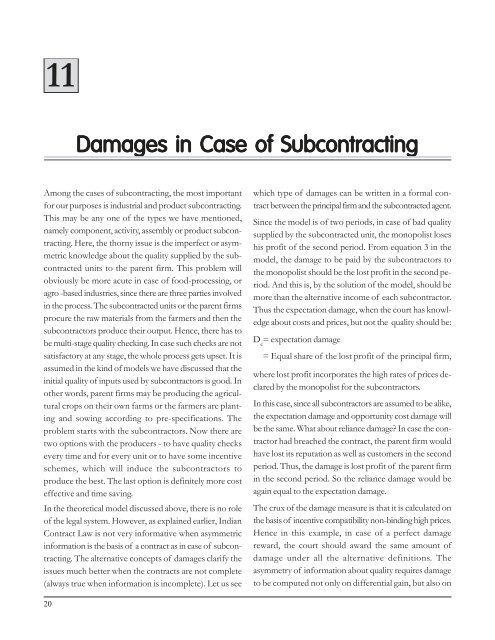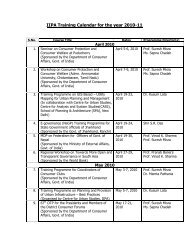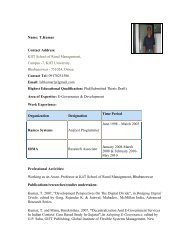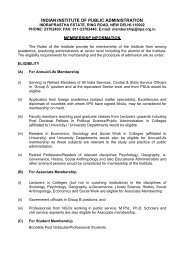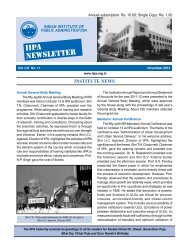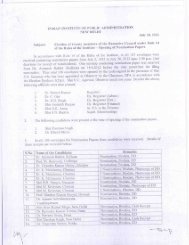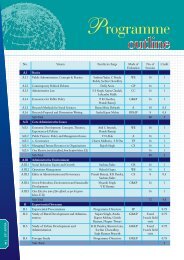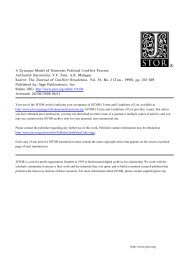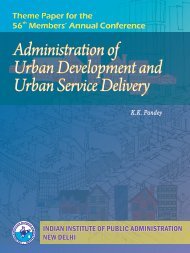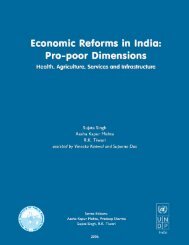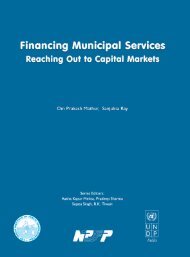Subcontracting and Economic - Indian Institute of Public Administration
Subcontracting and Economic - Indian Institute of Public Administration
Subcontracting and Economic - Indian Institute of Public Administration
Create successful ePaper yourself
Turn your PDF publications into a flip-book with our unique Google optimized e-Paper software.
<strong>Subcontracting</strong> And <strong>Economic</strong> Reforms In India With Special Reference To Agro-based Industries In India<br />
11<br />
Damages in Case <strong>of</strong> <strong>Subcontracting</strong><br />
Among the cases <strong>of</strong> subcontracting, the most important<br />
for our purposes is industrial <strong>and</strong> product subcontracting.<br />
This may be any one <strong>of</strong> the types we have mentioned,<br />
namely component, activity, assembly or product subcontracting.<br />
Here, the thorny issue is the imperfect or asymmetric<br />
knowledge about the quality supplied by the subcontracted<br />
units to the parent firm. This problem will<br />
obviously be more acute in case <strong>of</strong> food-processing, or<br />
agro -based industries, since there are three parties involved<br />
in the process. The subcontracted units or the parent firms<br />
procure the raw materials from the farmers <strong>and</strong> then the<br />
subcontractors produce their output. Hence, there has to<br />
be multi-stage quality checking. In case such checks are not<br />
satisfactory at any stage, the whole process gets upset. It is<br />
assumed in the kind <strong>of</strong> models we have discussed that the<br />
initial quality <strong>of</strong> inputs used by subcontractors is good. In<br />
other words, parent firms may be producing the agricultural<br />
crops on their own farms or the farmers are planting<br />
<strong>and</strong> sowing according to pre-specifications. The<br />
problem starts with the subcontractors. Now there are<br />
two options with the producers - to have quality checks<br />
every time <strong>and</strong> for every unit or to have some incentive<br />
schemes, which will induce the subcontractors to<br />
produce the best. The last option is definitely more cost<br />
effective <strong>and</strong> time saving.<br />
In the theoretical model discussed above, there is no role<br />
<strong>of</strong> the legal system. However, as explained earlier, <strong>Indian</strong><br />
Contract Law is not very informative when asymmetric<br />
information is the basis <strong>of</strong> a contract as in case <strong>of</strong> subcontracting.<br />
The alternative concepts <strong>of</strong> damages clarify the<br />
issues much better when the contracts are not complete<br />
(always true when information is incomplete). Let us see<br />
which type <strong>of</strong> damages can be written in a formal contract<br />
between the principal firm <strong>and</strong> the subcontracted agent.<br />
Since the model is <strong>of</strong> two periods, in case <strong>of</strong> bad quality<br />
supplied by the subcontracted unit, the monopolist loses<br />
his pr<strong>of</strong>it <strong>of</strong> the second period. From equation 3 in the<br />
model, the damage to be paid by the subcontractors to<br />
the monopolist should be the lost pr<strong>of</strong>it in the second period.<br />
And this is, by the solution <strong>of</strong> the model, should be<br />
more than the alternative income <strong>of</strong> each subcontractor.<br />
Thus the expectation damage, when the court has knowledge<br />
about costs <strong>and</strong> prices, but not the quality should be:<br />
D e<br />
= expectation damage<br />
= Equal share <strong>of</strong> the lost pr<strong>of</strong>it <strong>of</strong> the principal firm,<br />
where lost pr<strong>of</strong>it incorporates the high rates <strong>of</strong> prices declared<br />
by the monopolist for the subcontractors.<br />
In this case, since all subcontractors are assumed to be alike,<br />
the expectation damage <strong>and</strong> opportunity cost damage will<br />
be the same. What about reliance damage? In case the contractor<br />
had breached the contract, the parent firm would<br />
have lost its reputation as well as customers in the second<br />
period. Thus, the damage is lost pr<strong>of</strong>it <strong>of</strong> the parent firm<br />
in the second period. So the reliance damage would be<br />
again equal to the expectation damage.<br />
The crux <strong>of</strong> the damage measure is that it is calculated on<br />
the basis <strong>of</strong> incentive compatibility non-binding high prices.<br />
Hence in this example, in case <strong>of</strong> a perfect damage<br />
reward, the court should award the same amount <strong>of</strong><br />
damage under all the alternative definitions. The<br />
asymmetry <strong>of</strong> information about quality requires damage<br />
to be computed not only on differential gain, but also on<br />
20


